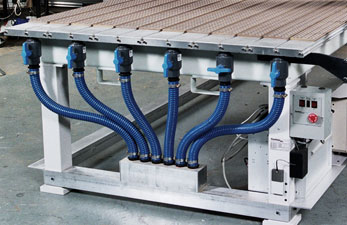CNC vacuum tables are essential tools in modern manufacturing, providing precision and efficiency for various applications. Understanding their functionality and benefits can significantly enhance production processes. This guide delves into the intricacies of CNC vacuum tables, exploring their design, operation, and advantages in different industries.
Readers can expect to learn about the various types of vacuum tables, their components, and how to select the right one for specific projects. Additionally, we will cover maintenance tips and troubleshooting techniques to ensure optimal performance. By the end of this guide, you will have a comprehensive understanding of CNC vacuum tables and their role in enhancing productivity and accuracy in machining tasks.
Definitive Guide to Router Vacuum Tables and Pumps for CNC & DIY

Vacuum Tables are often the best solution for the flat sheet work often being done on CNC Routers. You can lay an MDF spoilboard right on top of a vacuum table, and it’s porous enough to still pull a vacuum. However, unless you have a lot of vacuum available, you may want to seal part of the spoil board so the area receiving the vacuum is limited. Vacuum tables can be set up with zones that can be turned on and off with valves as well.
Understanding Vacuum Tables
Vacuum tables are essential for securing workpieces during CNC machining. They utilize atmospheric pressure to hold down parts, providing a reliable and efficient method for various materials. The technology has evolved significantly, addressing traditional limitations and enhancing usability.
Technical Features of Vacuum Tables
| Feature | Description |
|---|---|
| Holding Force | The force exerted by the vacuum, proportional to the area and pressure difference. |
| Surface Area | Larger surface areas provide more holding force, crucial for stability. |
| Zoning Capability | Allows selective vacuum application to different areas, enhancing efficiency. |
| Material Compatibility | Suitable for various materials, including wood, plastics, and metals. |
| Ease of Setup | Quick setup with minimal preparation time, reducing production delays. |
Types of Vacuum Tables
| Type | Description |
|---|---|
| Traditional Vacuum Tables | Basic design, often limited by size and material compatibility. |
| Zoned Vacuum Tables | Feature multiple zones for targeted vacuum application, improving efficiency. |
| Slimline Vacuum Tables | Compact design, ideal for smaller machines, requiring less powerful pumps. |
| Custom Vacuum Tables | Tailored solutions for specific applications, offering flexibility and precision. |
Advantages of Vacuum Tables
-
Efficiency: Vacuum tables streamline the machining process, allowing for quick part changes and minimal setup time. This is particularly beneficial in high-volume production environments.
-
Versatility: They can accommodate a wide range of materials, making them suitable for various applications, from woodworking to metal fabrication.
-
Precision: The ability to hold parts securely without mechanical clamps ensures high precision during machining, reducing the risk of errors.
-
Reduced Waste: By eliminating the need for screws or clamps, vacuum tables minimize material waste, allowing for more efficient use of resources.
-
Improved Safety: Securely holding parts reduces the risk of accidents caused by loose or shifting materials during machining.
Key Considerations When Choosing a Vacuum Table
When selecting a vacuum table, consider the following factors:
– Size and Capacity: Ensure the table can accommodate the size of your workpieces and the required holding force.
– Material Compatibility: Choose a table that works well with the materials you plan to use, whether wood, plastic, or metal.
– Pump Requirements: Assess the vacuum pump’s capacity to ensure it meets the demands of your specific applications.
– Zoning Features: If working with various part sizes, consider a zoned vacuum table for enhanced flexibility.
Conclusion
Vacuum tables are a vital component in modern CNC machining, offering numerous advantages over traditional clamping methods. With advancements in technology, they have become more versatile, efficient, and user-friendly. Whether you’re a DIY enthusiast or a professional machinist, investing in a quality vacuum table can significantly enhance your workflow and productivity.
FAQs
1. What is a vacuum table?
A vacuum table is a workholding device that uses atmospheric pressure to secure parts during CNC machining, providing a stable and efficient method for various materials.
2. How does a vacuum table work?
It creates a pressure difference between the atmospheric pressure above the part and the vacuum below, holding the part securely in place.
3. Can I use a vacuum table for different materials?
Yes, vacuum tables are compatible with various materials, including wood, plastics, and metals, making them versatile for different applications.
4. What are the benefits of using a vacuum table?
Benefits include increased efficiency, precision, reduced waste, and improved safety during machining processes.
5. Where can I find more information about vacuum tables?
You can explore resources on websites like www.cnccookbook.com, airweights.com, idcwoodcraft.com, vacuum-tables.com, and www.datron.com for detailed insights and product offerings.









